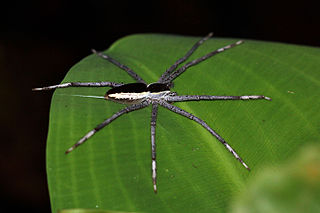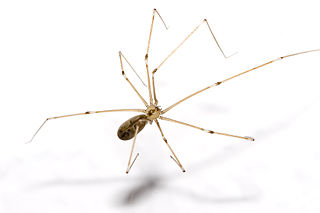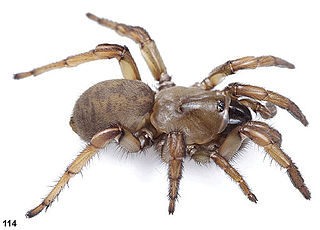
Arachnida is a class of joint-legged invertebrate animals (arthropods), in the subphylum Chelicerata. Arachnida includes orders containing spiders, scorpions, ticks, mites, harvestmen, and solifuges. In 2019, a molecular phylogenetic study also placed horseshoe crabs in Arachnida.

Huntsman spiders, members of the family Sparassidae, are known by this name because of their speed and mode of hunting. They are also called giant crab spiders because of their size and appearance. Larger species sometimes are referred to as wood spiders, because of their preference for woody places. In southern Africa the genus Palystes are known as rain spiders or lizard-eating spiders. Commonly they are confused with baboon spiders from the Mygalomorphae infraorder, which are not closely related.

Nursery web spiders (Pisauridae) is a family of araneomorph spiders first described by Eugène Simon in 1890. They resemble wolf spiders (Lycosidae) except for several key differences. Wolf spiders have two very prominent eyes in addition to the other six, while a nursery web spider's eyes are all about the same size. Additionally, female nursery web spiders carry their egg sacs with their jaws and pedipalps instead of attaching them to their spinnerets as wolf spiders do. When the eggs are about to hatch, a female spider builds a nursery "tent", places her egg sac inside, and stands guard outside, hence the family's common name. Like the wolf spiders, however, the nursery web spiders are roaming hunters that don't use webs for catching prey. They have a wide variety of prey, and larger species may prey upon vertebrates, particularly amphibians and fish.

The Pholcidae are a family of araneomorph spiders. The family contains over 1,800 pholcids, including those commonly known as the marbled cellar spider , daddy long-legs spider, granddaddy long-legs spider, carpenter spider, daddy long-legger, vibrating spider, gyrating spider, long daddy, and skull spider. The family, first described by Carl Ludwig Koch in 1850, is divided into 94 genera.

The sac spiders of the family Clubionidae have a very confusing taxonomic history. Once, this family was a large catch-all taxon for a disparate collection of spiders, similar only in that they had eight eyes arranged in two rows and conical anterior spinnerets that touched, and were wandering predators that built silken retreats, or sacs, usually on plant terminals, between leaves, under bark, or under rocks. These are now recognized to include several families, some of which are more closely related to the three-clawed spiders, like lynx and wolf spiders, than to Clubionidae and related families.

Rugathodes bellicosus is a small theridiid spider that occurs in Europe, including Russia. It is usually found on high ground, but also occurs on coasts. They live under large stones.

Bathyphantes is a genus of dwarf spiders that was first described by Anton Menge in 1866.

Wamba crispulus is a species of cobweb spider in the family Theridiidae. It is found in a range from Canada to Brazil and the Caribbean.
Centromerus cornupalpis is a species of sheetweb spider in the family Linyphiidae. It is found in the USA and Canada. This species exhibits sexual dimorphism. Males are identifiable by the shape of the cymbium, radix, and possession of a long proximo-dorsal horn on the paracymbium. Females exhibit a narrow, smooth constricted scape that originates anteriorly to the postero-lateral corners of the epigynum.

Araneus juniperi is a species of spider in the orb weaver family (Araneidae). It is found in the USA and Canada.
Bathyphantes pallidus is a species of sheetweb spider in the family Linyphiidae. It is found in the United States and Canada.
Urozelotes rusticus is a species of ground spider found in both Americas, Africa, Europe, Asia, Australia. Its native area is unknown, but it is most likely Old World.

Aptostichus stanfordianus, the Stanford Hills trapdoor spider, is a species of wafer-lid trapdoor spider (Euctenizidae) endemic to California in the United States.
Bathyphantes alboventris is a species of sheetweb spider in the family Linyphiidae. It is found in the United States and Canada.
Bathyphantes keeni is a species of sheetweb spider in the family Linyphiidae. It is found in Canada and the United States.
Bathyphantes alascensis is a species of sheetweb spider in the family Linyphiidae. It is found in the United States and Canada.
Bathyphantes brevipes is a species of sheetweb spider in the family Linyphiidae. It is found in the United States and Canada.
Bathyphantes orica is a species of sheetweb spider in the family Linyphiidae. It is found in the United States and Canada.
Bathyphantes brevis is a species of sheetweb spider in the family Linyphiidae. It is found in the United States and Canada.









